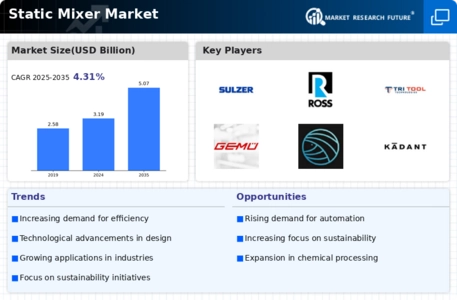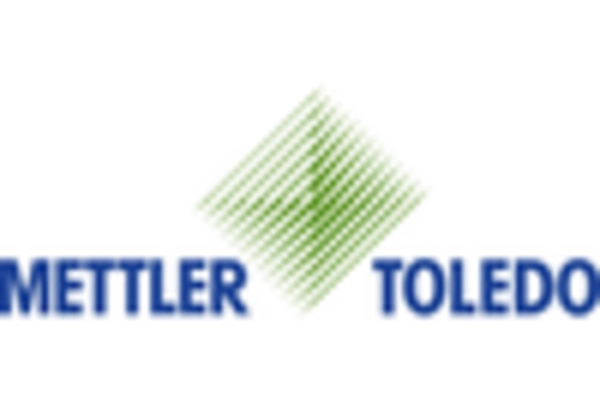Growth in Water Treatment Processes
The Static Mixer Market is also benefiting from the growing emphasis on water treatment processes. With increasing concerns over water quality and environmental sustainability, static mixers are being employed in various water treatment applications, including chemical dosing and flocculation. The market for static mixers in water treatment is expected to expand at a compound annual growth rate of approximately 6.1%, reflecting the rising investments in infrastructure and technology aimed at improving water quality. This trend underscores the critical role of static mixers in achieving efficient and effective water treatment solutions, thereby enhancing public health and environmental protection.
Increased Focus on Energy Efficiency
The Static Mixer Market is increasingly influenced by the global focus on energy efficiency and sustainability. As industries strive to reduce their carbon footprint, static mixers are recognized for their ability to minimize energy consumption during mixing processes. The adoption of static mixers can lead to significant energy savings, making them an attractive option for manufacturers aiming to enhance their sustainability initiatives. The market is projected to grow as companies prioritize energy-efficient solutions, with static mixers playing a crucial role in achieving these objectives. This trend indicates a shift towards more environmentally friendly practices within various sectors, further solidifying the importance of static mixers.
Rising Demand in Chemical Processing
The Static Mixer Market is experiencing a notable increase in demand, particularly within the chemical processing sector. This growth is driven by the need for efficient mixing solutions that enhance product quality and reduce processing times. As industries strive for higher productivity, static mixers are becoming essential for applications such as polymer blending and chemical reactions. The market for static mixers in chemical processing is projected to grow at a compound annual growth rate of approximately 5.2% over the next few years. This trend indicates a robust expansion, as manufacturers seek to optimize their operations and minimize energy consumption, thereby reinforcing the importance of static mixers in modern chemical processing.
Expansion in Food and Beverage Applications
The Static Mixer Market is witnessing significant expansion in the food and beverage sector, where the demand for consistent product quality is paramount. Static mixers are increasingly utilized for applications such as emulsification, blending, and homogenization, ensuring uniformity in food products. The market for static mixers in this sector is anticipated to grow at a rate of around 4.8% annually, driven by consumer preferences for high-quality and safe food products. As food safety regulations become more stringent, manufacturers are likely to invest in advanced mixing technologies, further propelling the adoption of static mixers in food and beverage applications.
Technological Innovations in Mixing Solutions
Technological innovations are playing a pivotal role in shaping the Static Mixer Market. Advances in materials and design are leading to the development of more efficient static mixers that offer improved performance and durability. Innovations such as enhanced mixing elements and modular designs are enabling manufacturers to tailor solutions to specific applications, thereby increasing the versatility of static mixers. The market is likely to see a surge in demand for these advanced mixing solutions, as industries seek to adopt cutting-edge technologies that enhance operational efficiency and reduce costs. This trend suggests a promising future for static mixers as integral components in various industrial processes.


















Leave a Comment